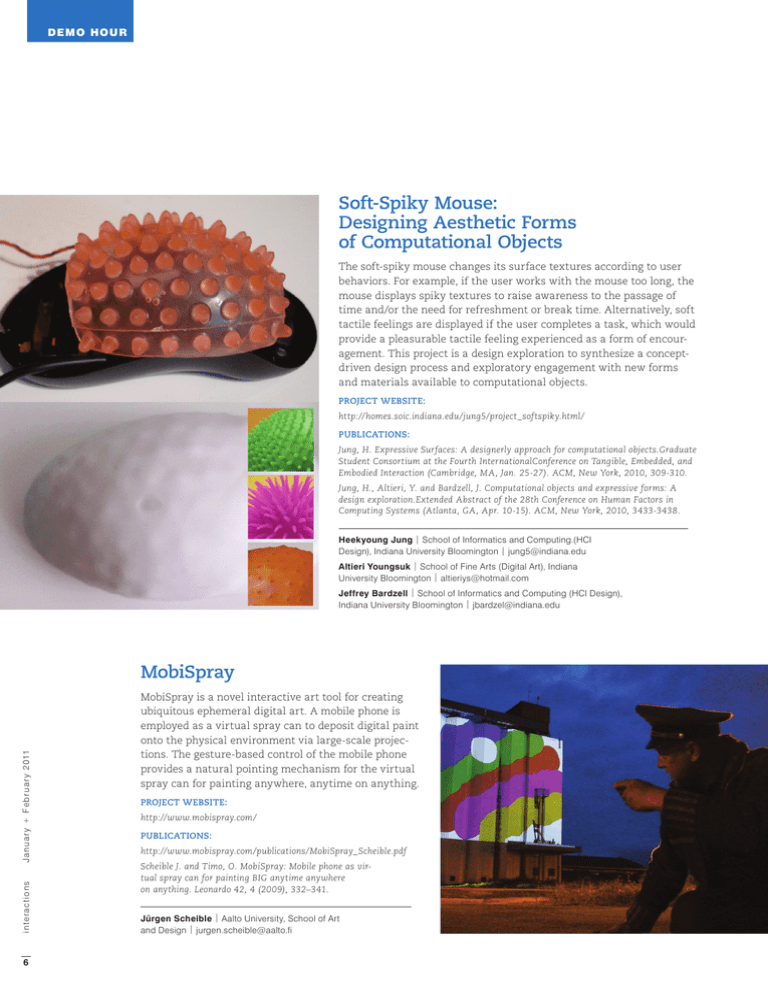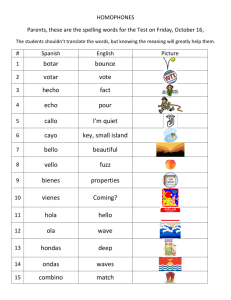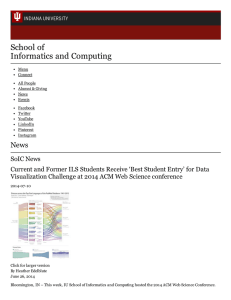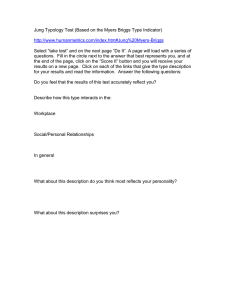Soft-Spiky Mouse: Designing Aesthetic Forms of Computational Objects demo hour
advertisement

Demo Hour Soft-Spiky Mouse: Designing Aesthetic Forms of Computational Objects The soft-spiky mouse changes its surface textures according to user behaviors. For example, if the user works with the mouse too long, the mouse displays spiky textures to raise awareness to the passage of time and/or the need for refreshment or break time. Alternatively, soft tactile feelings are displayed if the user completes a task, which would provide a pleasurable tactile feeling experienced as a form of encouragement. This project is a design exploration to synthesize a conceptdriven design process and exploratory engagement with new forms and materials available to computational objects. Project website: http://homes.soic.indiana.edu/jung5/project_softspiky.html/ Publications: Jung, H. Expressive Surfaces: A designerly approach for computational objects.Graduate Student Consortium at the Fourth InternationalConference on Tangible, Embedded, and Embodied Interaction (Cambridge, MA, Jan. 25-27). ACM, New York, 2010, 309-310. Jung, H., Altieri, Y. and Bardzell, J. Computational objects and expressive forms: A design exploration.Extended Abstract of the 28th Conference on Human Factors in Computing Systems (Atlanta, GA, Apr. 10-15). ACM, New York, 2010, 3433-3438. Heekyoung Jung | School of Informatics and Computing.(HCI Design), Indiana University Bloomington | jung5@indiana.edu Altieri Youngsuk | School of Fine Arts (Digital Art), Indiana University Bloomington | altieriys@hotmail.com Jeffrey Bardzell | School of Informatics and Computing (HCI Design), Indiana University Bloomington | jbardzel@indiana.edu i n t e r a c t i o n s J a n u a r y + F e b r u a r y 2 0 11 MobiSpray 6 MobiSpray is a novel interactive art tool for creating ubiquitous ephemeral digital art. A mobile phone is employed as a virtual spray can to deposit digital paint onto the physical environment via large-scale projections. The gesture-based control of the mobile phone provides a natural pointing mechanism for the virtual spray can for painting anywhere, anytime on anything. Project website: http://www.mobispray.com/ Publications: http://www.mobispray.com/publications/MobiSpray_ Scheible.pdf Scheible J. and Timo, O. MobiSpray: Mobile phone as virtual spray can for painting BIG anytime anywhere on anything. Leonardo 42, 4 (2009), 332–341. Jürgen Scheible | Aalto University, School of Art and Design | jurgen.scheible@aalto.fi demo hour Energy Mementos Energy Mementos are provocative objects designed to explore the energy analog of physical mementos or keepsakes. For example, shaking the Shake-Light Bottle collects energy and stores energy metadata about how it was collected. Removing the cap activates the collected energy, causing the bottle to glow in unique patterns based on the energy metadata (e.g., the age of the energy). One usage scenario is giving the Energy Memento as a gift of one’s own energy. Energy Mementos raise questions such as: Can we become attached to particular energies? How can and cannot we experience energy as we experience material things? Project website: http://www.living-environments.net/ Publication: Pierce, J. and Paulos, E. Materializing Energy. Proceedings of DIS Conference on Designing Interactive Systems (DIS ’10) (Arhus, Denmark, Aug. 16-20) ACM, New York. James Pierce | Living Environments Laboratory, HumanComputer Interaction Institute, CMU | jjpierce@cs.cmu.edu Eric Paulos | Living Environments Laboratory, HumanComputer Interaction Institute, CMU | eric@paulos.net Cally and Callo: The Robot Cell Phone The project “Cally and Callo” aims to integrate human social characteristics with mobile phone services. The prototypes are a combination of an old-school smartphone and a robot kit. A phone device is the robot face and also functions as the “brain.” The mobile apps are built on Symbian S60 to handle phone native functionalities such as telephony, SMS, and video call. Cally and Callo register various “facial” and “body” expressions to indicate incoming calls from different groups of people. The robots can recognize emoticons and user-created gesture animations from SMS text messages. What’s more, the two Callo robots can synchronize their gestures: If you set a movement for your Callo, the robot on the other end of the video call moves in exactly the same way. Project website: http://cally.iat.sfu.ca/ Publications: Yim, J., Chun, S., Jung, K. and Shaw, C.D. Development of Communication Model for Social Robots based on Mobile Service. The Second IEEE International Conference on Social Computing (SocialCom2010), (Minneapolis, MN, Aug. 20-22). Yim, J. and Shaw, C.D. Designing CALLY, a Cell-phone Robot. Proceedings of CHI’09 Conference on Human Factors in Computing Systems. (Boston, MA, Apr. 4-9). ACM, New York, 2009. Ji-Dong Yim | Simon Fraser University | jdyim@sfu.ca Christopher Shaw | Simon Fraser University | shaw@sfu.ca DOI: 10.1145/1897239.1897241 © 2011 ACM 1072-5220/11/0100 $10.00 7





